Stars, Myth, Facts, Location – Constellation Guide (original) (raw)
Hydra, the water snake, is the largest constellation in the sky. It lies in the southern celestial hemisphere, stretching across 1303 square degrees of the southern sky.
Hydra’s head is located south of the constellation Cancer and its tail lies between Centaurus and Libra. The constellation was first catalogued by the Greek astronomer Ptolemy in the 2nd century. It represents the Lernaean Hydra from the Greek myth of Heracles’ Twelve Labours. Sometimes it is taken to represent the water snake from the myth about the crow that tried to trick the god Apollo by blaming the snake for its tardiness in fetching the god some water.
Notable deep sky objects in Hydra include the open cluster Messier 48, the globular cluster Messier 68, the Southern Pinwheel Galaxy (Messier 83), the Hydra Cluster of galaxies, the Porpoise Galaxy (NGC 2936), Tombaugh’s Globular Cluster (NGC 5694), the Ghost of Jupiter nebula, and the spiral galaxy ESO 510-G13.
Facts, location and map
Hydra is the largest of the 88 constellations. It occupies an area of 1303 square degrees in the night sky. The constellation lies in the second quadrant of the southern hemisphere (SQ2) and can be seen at latitudes between +54° and -83°. The neighboring constellations are Antlia, Cancer, Canis Minor, Centaurus, Corvus, Crater, Leo, Libra, Lupus, Monoceros, Puppis, Pyxis, Sextans and Virgo.
The constellation name Hydra is pronounced /ˈhaɪdrə/. In English, the constellation is known as the Water Snake or the Female Water Snake. The genitive form of Hydra, used in star names, is Hydrae (pronunciation: /ˈhaɪdriː/). The three-letter abbreviation, adopted by the International Astronomical Union (IAU) in 1922, is Hya.
Hydra belongs to the Hercules family of constellations, along with Aquila, Ara, Centaurus, Corona Australis, Corvus, Crater, Crux, Cygnus, Hercules, Lupus, Lyra, Ophiuchus, Sagitta, Scutum, Sextans, Serpens, Triangulum Australe and Vulpecula.
Hydra is one of the 15 equatorial constellations. It contains nine named stars. The star names approved by the International Astronomical Union (IAU) are Alphard, Ashlesha, Felis, Filetdor, Lerna, Minchir, Solitaire, Ukdah, and Zhang.
Hydra contains three Messier objects: Messier 48 (M48, NGC 2548), Messier 68 (M68, NGC 4590), and Messier 83 (Southern Pinwheel Galaxy, M83, NGC 5236). It has 13 stars with known planets. The brightest star in Hydra constellation is Alphard, Alpha Hydrae, with an apparent magnitude of 1.98. There are two meteor showers associated with the constellation: the Alpha Hydrids and the Sigma Hydrids.
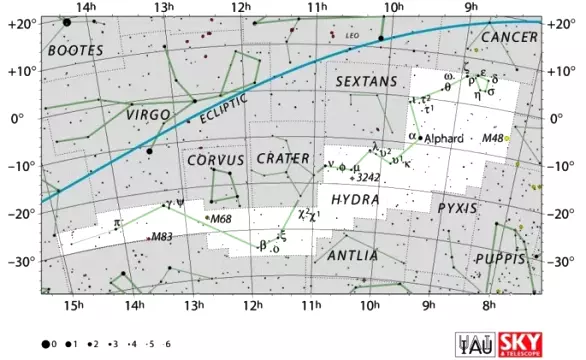
Hydra constellation map by IAU and Sky&Telescope magazine
Hydra constellation as depicted by the Greeks is an adaptation of the Babylonian constellation MUL.DINGIR.MUŠ, which was one of the two Babylonian constellations that represented a serpent and loosely corresponded to Hydra. The other constellation corresponded to the Greek constellation Serpens. The Babylonian constellation represented a mythological hybrid of a serpent, bird and lion.
Hydra constellation is usually associated with the second of Heracles’ labours in Greek mythology. Hydra was a giant multi-headed creature fathered by the monster Typhon and Echidna, who was half-woman, half-serpent. The dragon Ladon, that guarded the garden of the Hesperides, was Hydra’s brother. The dragon, also defeated by Heracles, is represented by the constellation Draco, while the hero is commemorated by the constellation Hercules.
In mythology, Hydra had nine heads and one of them was immortal. The celestial Hydra is depicted with only one head, presumably the immortal one.
The monster lived near the town of Lerna, where it ravaged the land. Heracles, faced with a difficult task, first aimed flaming arrows into the Hydra’s lair and smoked it out. Then he fought with it, smashing the creature’s heads one by one with his club. Every time he smashed one, two new heads would grow in its place. While the two fought, Heracles was distracted by a crab, which crawled out of the swamp and went for his foot. Heracles did away with the crab and Hera placed it among the stars as the constellation Cancer.
Heracles was able to defeat the Hydra when his charioteer Iolaus helped him by burning the stumps of each head that Heracles struck off, and eventually Heracles cut off the immortal head and buried it under a rock. He dipped his arrows in Hydra’s poisonous blood, which would eventually lead to his own end.
In a different myth, the constellation Hydra is associated with the water snake on which Apollo’s crow blamed its tardiness. The god had sent the bird, represented by the constellation Corvus, to fetch him some water in a cup. The cup is associated with the constellation Crater. The crow was distracted by a fig tree and stopped to feast. When it finally returned to Apollo, it said the water snake was to blame, but the god saw through the bird’s lie and punished it by placing it into the sky. Apollo also turned the water snake and the cup into constellations. In the sky, the water snake (Hydra) eternally prevents the crow (Corvus) from drinking out of the cup (Crater).
Hydra stars
Alphard – α Hydrae (Alpha Hydrae)
Alpha Hydrae has an apparent magnitude of 2.0 and is approximately 177 light years distant from the Sun. It is the brightest star in the constellation. Alpha Hydrae has the stellar classification K3 II-III, which places it halfway between an orange giant and bright giant. It has three solar masses, 50 times the solar radius, and is believed to be around 420 million years old.
The star’s proper name, Alphard, is derived from the Arabic al-fard, which means “the solitary one.” Danish astronomer Tycho Brahe called the star Cor Hydrae, or “the heart of the snake,” and Arabs knew it as the “backbone of the serpent.”
γ Hydrae (Gamma Hydrae)
Gamma Hydrae is the second brightest star in Hydra. It has an apparent magnitude of 2.993 and is 133.8 light years distant from Earth. It has the stellar classification of G8 III, which makes the star a yellow giant.
Gamma Hydrae has three solar masses and 13 times the solar radius. It is 115 times more luminous than the Sun, but significantly younger. Its age is estimated to be around 372 million years.
ζ Hydrae (Zeta Hydrae)
Zeta Hydrae is the third brightest star in Hydra constellation, with an apparent magnitude of 3.10. It has the stellar classification G9 II-III and is approximately 167 light years distant. The star is believed to be around 400 million years old.
Zeta Hydrae is an evolved giant in the luminosity class between a giant and bright giant. It is 132 times more luminous than the Sun, has 18 times the Sun’s radius and 4.2 solar masses.
β Hydrae (Beta Hydrae)
Beta Hydrae is a binary star 370 light years distant from the solar system. It has a combined apparent magnitude of 4.276, which varies by 0.04 magnitudes over a period of 2.344 days.
The primary component in the system is a giant Bp star classified as an alpha-2 Canum Venaticorum type variable. It is a chemically peculiar class B star with a strong magnetic field.
27 Hydrae
27 Hydrae is an evolved yellow giant star with the stellar classification G8III-IV, 243.4 light years distant from the Sun. The star is believed to have a low-mass companion, an M class dwarf.
The system is believed to have a substellar companion orbiting it with a period of 9.3 years, but no planet has been confirmed yet. 27 Hydrae has an apparent magnitude of 4.82.
Minchir – σ Hydrae (Sigma Hydrae)
Sigma Hydrae has the stellar classification K1III – an orange giant – and an apparent magnitude of 4.44. It is approximately 353 light years distant from the Sun.
The star’s traditional name, Minchir, is derived from the Arabic Minkhir al-Shuja, which means “the nostril of Hydra.”
R Hydrae
R Hydrae is a Myra-type variable star, a red pulsating variable star in the late stage of evolution, with the stellar classification of M7IIIe. It is a red giant with an apparent magnitude that slowly changes from 3.5 to 10.9 over a period of 389 days. The star is approximately 410 light years distant.
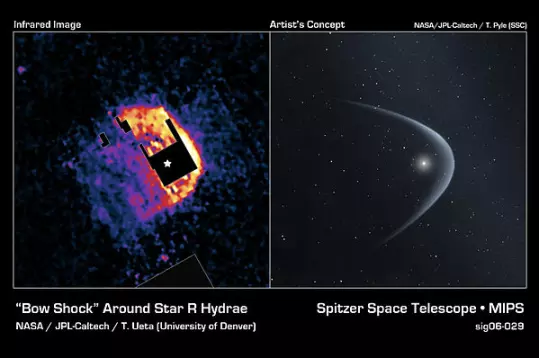
This image from the Spitzer Space Telescope (left panel) shows the “bow shock” of a star named R Hydrae (R Hya) in the constellation Hydra. Bow shocks are formed where the stellar wind from a star are pushed into a bow shape (illustration, right panel) as the star plunges through the gas and dust between stars. Our own Sun has a bow shock, but prior to this image one had never been observed around this particular class of red giant star. R Hya moves through space at approximately 50 kilometers per second. As it does so, it discharges dust and gas into space. Because the star is relatively cool, that ejecta quickly assumes a solid state and collides with the interstellar medium. The resulting dusty nebula is invisible to the naked eye but can be detected using an infrared telescope. This bow shock is 16,295 AU from the star to the apex and 6,188 AU thick. 1 AU is the distance between the Sun and the Earth. The mass of the bow shock is about 400 times the mass of the Earth.
The false-color Spitzer image shows infrared emissions at 70 microns. Brighter colors represent greater intensities of infrared light at that wavelength. The location of the star itself is drawn onto the picture in the black unobserved region in the center. Image: NASA, JPL-Caltech, T. Ueta (Univ. of Denver)
V Hydrae
V Hydrae is a carbon star with the stellar classification C9I. It is one of the reddest stars in the night sky, with a B-V colour index of +5.5.
The star is classified as a semi-regular variable. Its apparent magnitude ranges from 7.0 to 11.5 over a period of about 18 years, with a sub-period of 530 days. V Hydrae is approximately 1,300 light years distant.
U Hydrae
U Hydrae is another carbon star in Hydra constellation. It is one of the few carbon stars that can be seen without binoculars. It is a bright giant with an apparent magnitude of 4.93, belonging to the spectral class C. The star is approximately 677 light years away.
U Hydrae is a variable star, showing variations in brightness ranging from 4.8 and 5.06 magnitudes over a period of 114.8 days.
ε Hydrae (Epsilon Hydrae)
Epsilon Hydrae is a multiple star system in Hydra. It is approximately 129 light years distant from Earth.
The system consists of at least four stars. The main component, the binary star Epsilon Hydrae AB, has an apparent magnitude of 3.38 and the stellar classification of G5 III + F0V, which means that it is composed of a yellow giant and a yellow white dwarf. The stars have an orbital period of 15 years and are separated by 0.2 arc seconds. Epsilon Hydrae A, the primary component, is 67 times more luminous than the Sun.
Epsilon Hydrae C is a spectroscopic binary star of the spectral type F5 with an apparent magnitude of 7.5. It is separated from the main pair by 3 seconds of arc. It has a period of 9.9047 days and orbits the main pair with a period of 870 years.
Epsilon Hydrae D is separated from the main pair by 19 seconds of arc and is believed to be gravitationally bound to the Epsilon Hydrae system because it shares a common proper motion with the other stars. The star has an estimated orbital period of 10,000 years.
ν Hydrae (Nu Hydrae)
Nu Hydrae is an orange giant star located near the border with Crater constellation. It has an apparent magnitude of 3.115 and is approximately 144 light years distant from the solar system.
The star has a radius 21 times solar and is 151 times more luminous than the Sun. It is a known X-ray source.
π Hydrae (Pi Hydrae)
Pi Hydrae has the stellar classification of K1 III-IV, which means that it is an orange star halfway between the subgiant and giant stage of evolution. It has a visual magnitude of 3.25 and is 101 light years distant from Earth. The star can be seen without binoculars. It has 2.45 solar masses and 12-13 times the Sun’s radius.
δ Hydrae (Delta Hydrae)
Delta Hydrae is a binary star in Hydra, about 17 times more luminous than the Sun. It has the stellar classification of A1V, which means that it is a white dwarf. The star is approximately 179 light years distant. It is sometimes known as Lisan al Shudja or Lingua Hydri, which means “the tongue of the snake.” Delta Hydrae has an apparent magnitude of 4.14.
Deep sky objects in Hydra
Messier 48 (M48, NGC 2548)
Messier 48 is an open star cluster in Hydra, believed to be about 300 million years old. It has an apparent magnitude of 5.5 and is approximately 1,500 light years distant from Earth. The cluster was discovered by Charles Messier in 1771. It can be seen without binoculars under good conditions.
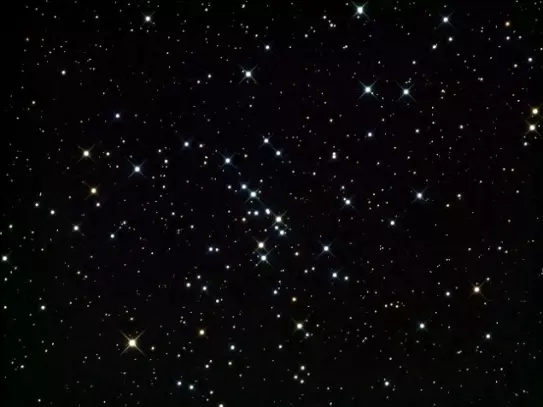
Messier 48, image: NASA
Messier 68 (M68, NGC 4590)
Messier 68 is a globular cluster in Hydra, also discovered by Charles Messier, in 1780. It has an apparent magnitude of 9.67 and is approximately 33,600 light years distant from the solar system.
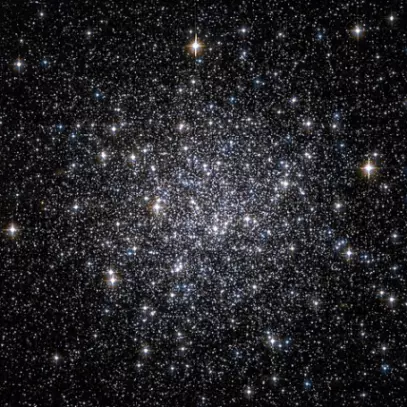
Messier 68, image: NASA/ESA (Hubble Space Telescope)
Hydra Cluster
Hydra Cluster is a galaxy cluster in Hydra. It spans 10 million light years and contains 157 bright galaxies, the largest of which are the ellipticals NGC 3309 and NGC 3311 and the spiral galaxy NGC 3312. These galaxies are all about 150,000 light years in diameter. The cluster is notable for having a high proportion of dark matter.
The Hydra Cluster is 190.1 million light years distant from the solar system. It is part of the larger Hydra-Centaurus Supercluster, which is approximately 158 million light years distant from the Sun and includes galaxies in the constellations Centaurus, Hydra and Norma.
Southern Pinwheel Galaxy – Messier 83 (M83, NGC 5236)
Messier 83, or the Southern Pinwheel Galaxy, is a barred spiral galaxy in Hydra. It has a visual magnitude of 7.54 and is approximately 14.7 million light years distant from the Sun. It bears a resemblance to the Pinwheel Galaxy (Messier 101) in Ursa Major constellation.
The Southern Pinwheel Galaxy is one of the nearest and brightest barred spirals discovered, and can be observed with binoculars.
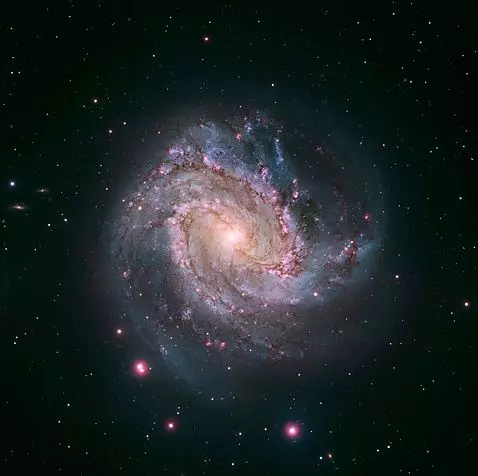
The Southern Pinwheel Galaxy (Messier 83), image: NASA, ESA, and the Hubble Heritage Team (STScI/AURA), acknowledgement: W. Blair (STScI/Johns Hopkins University) and R. O’Connell (University of Virginia)
Six supernovae have been observed in the galaxy in the last century: SN 1923A, SN 1945B, SN 1950B, SN 1957D, SN 1968L and SN 1983N.
The galaxy was discovered by the French astronomer Nicolas Louis de Lacaille on February 23, 1752 at the Cape of Good Hope, and Messier added it to his catalogue in March 1781.
Ghost of Jupiter – NGC 3242 (Caldwell 59)
NGC 3242 is a planetary nebula in Hydra. It has an apparent magnitude of 8.60 and is approximately 1,400 light years distant. The nebula was discovered by the German-born British astronomer William Herschel on February 7, 1785.
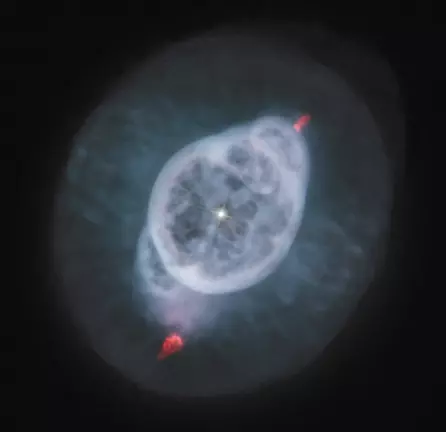
Ghost of Jupiter Nebula (NGC 3242), image: Judy Schmidt (CC BY 2.0)
His son John Herschel observed the nebula from the Cape of Good Hope in the 1830s and included it in the 1864 General Catalogue.
The nebula is usually called the Ghost of Jupiter or Jupiter’s Ghost, and sometimes also the Eye Nebula. It can easily be seen in amateur telescopes.
NGC 3109
NGC 3109 is a spiral or irregular galaxy in Hydra that is tidally interacting with the Antlia Dwarf, the dwarf elliptical galaxy located in Antlia constellation. As a result of the interaction, NGC 3109 has a warped disk.
The galaxy has an apparent magnitude of 10.4 and is approximately 4.3 million light years distant. It was discovered by John Herschel on March 24, 1835.
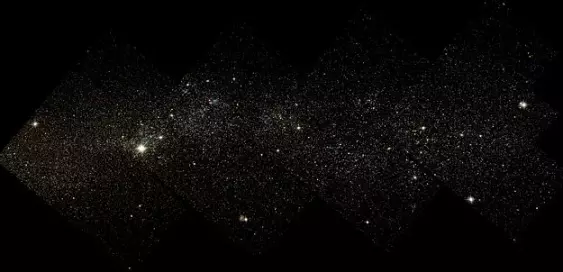
Part of the galaxy NGC 3109, by the Hubble Space Telescope, image: NASA/ESA – The Hubble Legacy Archive (HLA): Space Telescope Science Institute (STScI), the Space Telescope European Coordinating Facility (ST-ECF), and the Canadian Astronomy Data Centre (CADC) – zoranknez (Aladin software)
The galaxy is a Magellanic type irregular galaxy, but could also be a small spiral galaxy, the smallest one discovered in the Local Group.
It is notable for containing a large number of planetary nebulae and a considerable amount of dark matter.
NGC 3621
NGC 3621 is a spiral galaxy in Hydra. It has an apparent magnitude of 10.0 and is approximately 22 million light years distant from the solar system. It can easily be observed in moderate-sized telescopes.
NGC 3621 is a pure-disc galaxy: it does not have a central bulge.
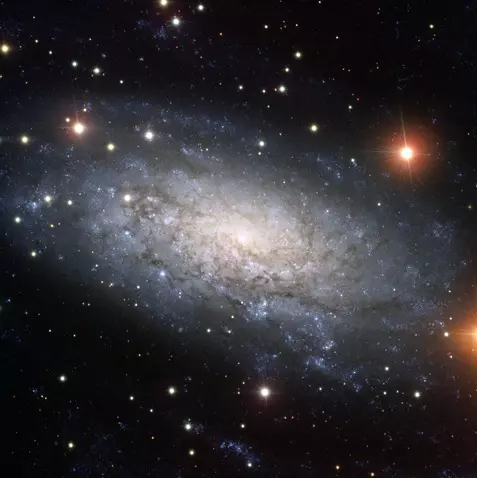
This image, from ESO’s Very Large Telescope (VLT), shows a truly remarkable galaxy known as NGC 3621. To begin with, it is a pure-disc galaxy. Like other spirals, it has a flat disc permeated by dark lanes of material and with prominent spiral arms where young stars are forming in clusters (the blue dots seen in the image). But while most spiral galaxies have a central bulge — a large group of old stars packed in a compact, spheroidal region — NGC 3621 doesn’t. In this image, it is clear that there is simply a brightening to the centre, but no actual bulge like the one in NGC 6744 (eso1118), for example. NGC 3621 is also interesting as it is believed to have an active supermassive black hole at its centre that is engulfing matter and producing radiation. This is somewhat unusual because most of these so-called active galactic nuclei exist in galaxies with prominent bulges. In this particular case, the supermassive black hole is thought to have a relatively small mass, of around 20 000 times that of the Sun. Another interesting feature is that there are also thought to be two smaller black holes, with masses of a few thousand times that of the Sun, near the nucleus of the galaxy. Therefore, NGC 3621 is an extremely interesting object which, despite not having a central bulge, has a system of three black holes in its central region. Image: ESO
Tombaugh’s Globular Cluster – NGC 5694 (Caldwell 66)
NGC 5694 is one of the oldest known globular clusters located in the Milky Way galaxy. It is believed to have formed almost 12 million years ago. The cluster has an apparent magnitude of 10.2. It was discovered by William Herschel in 1784. The American astronomer Clyde Tombaugh was the one to ascertain its status as globular cluster in 1932.
NGC 3054
NGC 3054 is an intermediate spiral galaxy with an apparent magnitude of 12.4. It was discovered by the German-American astronomer Christian Heinrich Friedrich Peters in 1859. A supernova, SN 2006T, was observed in the galaxy in January 2006.
ESO 510-G13 (PGC 49473)
ESO 510-G13 is another spiral galaxy in Hydra constellation. It has an apparent magnitude of 13.4 and is approximately 150 million light years distant from the solar system.
The galaxy has a heavily warped cloud of dust around the equator, which suggests that ESO 510-G13 may have interacted with another galaxy at some point in the past.
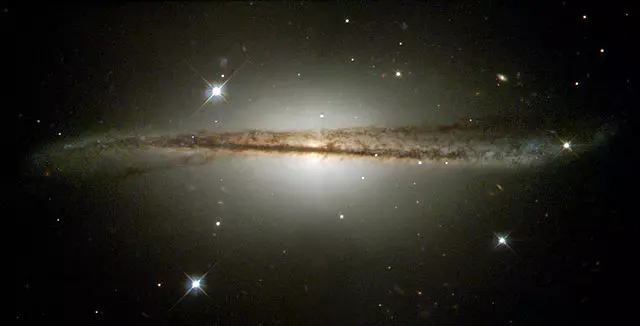
ESO 510-G13 – The strong warping of the disk indicates that ESO 510-G13 has recently undergone a collision with a nearby galaxy and is in the process of swallowing it. Gravitational forces distort the structures of the galaxies as their stars, gas, and dust merge together in a process that takes millions of years. Eventually the disturbances will fade out, and ESO 510-G13 will become a normal-appearing single galaxy. In the outer regions of ESO 510-G13, especially on the right-hand side of the image, we see that the twisted disk contains not only dark dust, but also bright clouds of blue stars. This shows that hot, young stars are being formed in the disk. Astronomers believe that the formation of new stars may be triggered by collisions between galaxies, as their interstellar clouds smash together and are compressed. Image: NASA and the Hubble Heritage Team
NGC 5078
NGC 5078 is a spiral galaxy in Hydra. It has an apparent magnitude of 11.8 and is approximately 94 million light years distant from the solar system.
NGC 3314
NGC 3314 consists of a pair of overlapping spiral galaxies in Hydra. They are 117 and 140 million light years distant and have a visual magnitude of 12.5. The two galaxies are not physically related.
NGC 3314a is the galaxy in the foreground, appearing face-on, and its interstellar dust appears dark against NGC 3314b, the galaxy in the background.
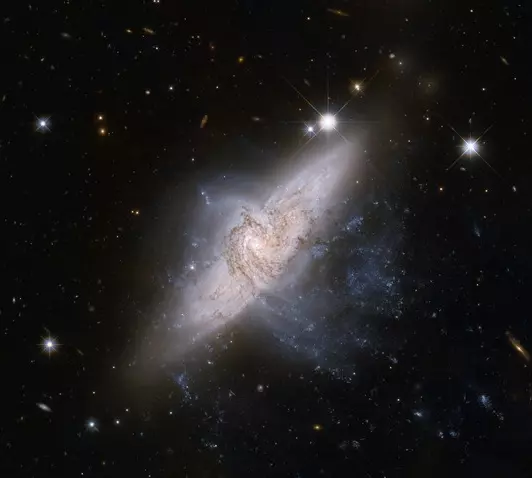
Overlapping galaxies NGC 3314a and NGC 3314b – The NASA/ESA Hubble Space Telescope has produced an incredibly detailed image of a pair of overlapping galaxies called NGC 3314. While the two galaxies look as if they are in the midst of a collision, this is in fact a trick of perspective: the two are in chance alignment from our vantage point. Image: NASA, ESA, the Hubble Heritage (STScI, AURA)-ESA, Hubble Collaboration, and W. Keel (University of Alabama)
NGC 4980
NGC 4980 is a spiral galaxy 80 million light years from Earth. It has a slightly deformed shape, even though there is no evidence of tidal interactions with another galaxy, as there are no other galaxies nearby.